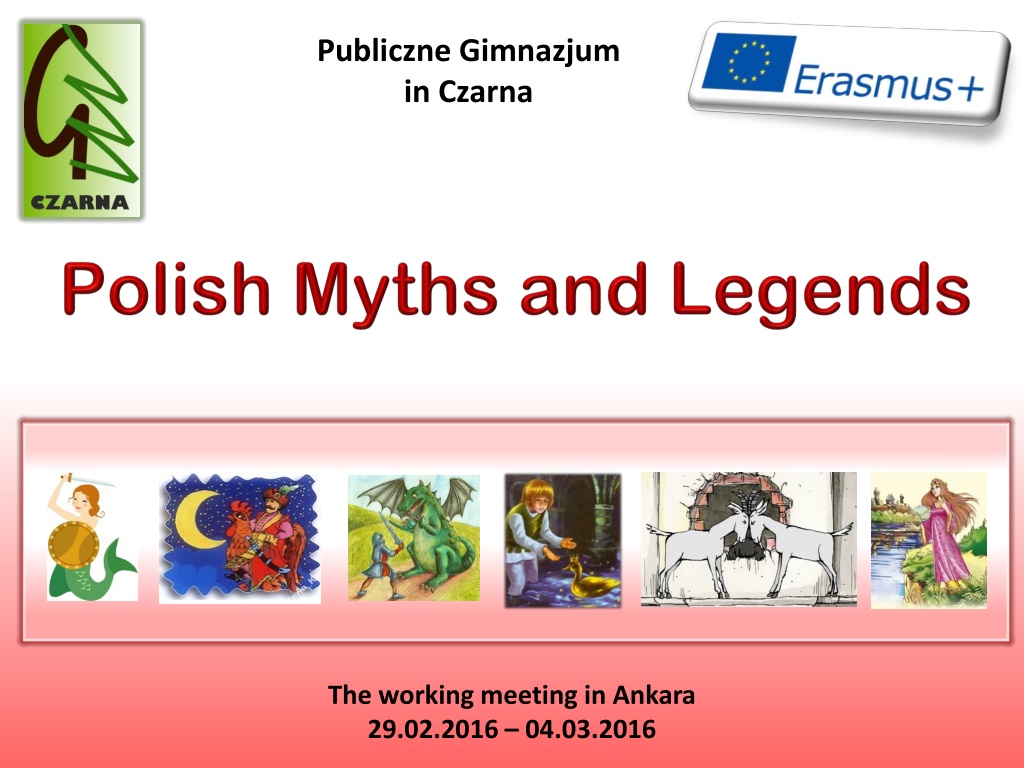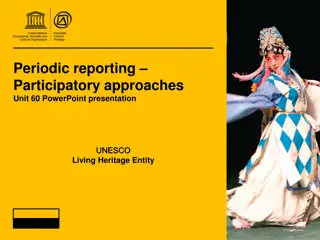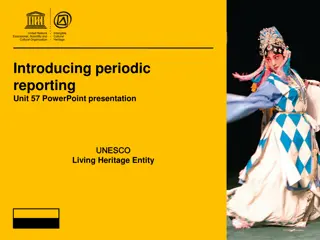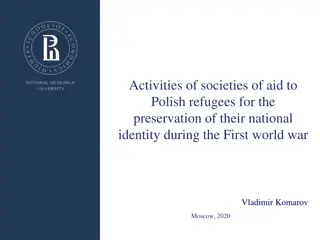Unveiling Polish Legends and Cultural Heritage
Explore the captivating legends and cultural heritage of Poland, from the origin of the name "Poland" to the legendary founding of Gniezno and the symbolic White Eagle. Delve into the rich history, myths, and traditions that shape the identity of this European country, revealing a tapestry of stories and beliefs passed down through generations.
Download Presentation

Please find below an Image/Link to download the presentation.
The content on the website is provided AS IS for your information and personal use only. It may not be sold, licensed, or shared on other websites without obtaining consent from the author. Download presentation by click this link. If you encounter any issues during the download, it is possible that the publisher has removed the file from their server.
E N D
Presentation Transcript
Publiczne Gimnazjum in Czarna The working meeting in Ankara 29.02.2016 04.03.2016
Can we know and understand other cultures? Of course! We can do it by travelling, which brings us a lot of aesthetic impressions, cater of curiosity, we can much better know other nationalities, histories and traditions, architectures and arts. Culture is a part of everyone of us. Precious relics are Europe countries fellow heritage. Thanks culture, art people become immoral. Culture is the key to understand man. What s more! Each country has its own legends and myths, which could be true or false, but each human being gets to know.
The name of Poland comes from the tribe of Polanie, who inhabited the territory of today s Wielkopolska. The word Polanie shall be translated as inhabiting the fields , as opposed to other tribes, e.g. Wi lanie and Mazowszanie, who inhabited forest regions. The name Poland started to be used with reference to the whole country in the XI century. The territories of Polanie were since XIV century called Staropolska, and then Wielkopolska. On the contrary southern territories were called Malopolska.
According to a popular legend the founder of the Polanie state, Lech, during his halt in the surroundings of Pozna saw in the evening a large nest in a tree. There was a white eagle with two nestlings in it. When Lech watched it closer, the eagle spread out its wings against sky red from the setting sun. Lech become enchanted, decided to settle there, put the eagle in his coat of arms and in remembrance called this place Gniezno from the Polish word gniazdo which means nest . Gniezno was the first capital of Poland.; the second one was Krak w and then up to now is Warszawa. https://opolczykpl.wordpress.com/2014/03/19/slowianszczyzna-i-legenda- o-lechu-czechu-i-rusie/
In the Polish version of the legend, three brothers went hunting together but each of them followed a different prey and eventually they all travelled in different directions. Rus went to the east, Czech headed to the west to settle on the p Mountain rising up from the Bohemian hilly countryside, while Lech travelled north. There, while hunting, he followed his arrow and suddenly found himself face-to- face with a fierce, white eagle guarding its nest from intruders. Seeing the eagle against the red of the setting sun, Lech took this as a good omen and decided to settle there. He named his settlement Gniezno (Polish gniazdo - 'nest') in commemoration and adopted the White Eagle as his coat-of-arms. The white eagle remains a symbol of Poland to this day, and the colors of the eagle and the setting sun are depicted in Poland's coat of arms.
There is a legend about the name of Warszawa that derives it from the names of twins Wars and Sawa. Their godfather was a Polish king, who had hunted at this place. Thanks to the king's bounty the twins established a settlement, which grew into a city - Warsaw. In fact, the name of the city derives from the name of Warcislaw (Warsz in short), who was the owner of the settlement. Many villages took their names from their owner's name, with '-owa' added to the end of the name - hence Warszowa (Warszawa). https://pl.wikipedia.org/wiki/Herb_Warszawy http://www.wiatrak.nl/11555/warszawa-walczy
Once upon a time there lived Mr Twardowski, a good nobleman, who wanted to have more wisdom than ordinary, simple people. He wanted to invent a drug against death so that he could live eternally. Once he had in an old book, that this can be done by devil only. So he started calling him at midnight. The devil wrote a long pledge, which Mr Twardowski signed with his own blood pressed from his finger. In the contract the provisions of pact with devil were outlined. The satan could take neither the body nor the soul of Mr Twardowski unless in Rome. Only there the devil could grab him. So Twardowski ordered the devil, whatever he wished, e.g. to bring silver from the whole of Poland to one place and shed sand on it. So he was flying in the air without wings. He was riding a painted horse, he mounted a cock and was at the destination place quicker. One day however the devil requested the soul of the nobleman. Pretending to be courtier he invited Twardowski to his lord to apply aid to him. When the nobleman came to the place, he got to know, that the name of the inn is Rome .
He did not want to give his soul to the devil at any price. So he ascended so high, that he remained hanging on the Moon. Today, when people are watching from Earth, the see a dark patch on the Moon. This is the body of Mr Twardowski. At least so the legend goes.
In a cave at the bottom of the Wawel Hill there lived a terrible fire- belching dragon. The dragon roamed around the countryside and did whatever he wanted to. He ate sheep and cattle and scared the farmers so much that he didn t let their animals graze in the field near the Vistula River. Many brave knights had tried to kill the monster, but therefore they could get close enough to him, he blew fire on them and they princess, but the dragon killed them. The people became even frightened; they were afraid to leave their homes and the country became poorer. One day, a young, handsome but poor shoemaker s apprentice named Krak asked the king if he could try to slay the dragon. The king said that he could try, but noted that he had no armor, no horse and no sword. The apprentice had only his shoemaker tools and a plan. could marry the http://www.spsosnowice.hostit.pl/ilustracje_legendy/slides/31.html
Krak bought butcher and some sulphur (a powder that is used in making matches) from a miner. Then he cut the sheep open with his sharp shoemaker s knife thread. He put the sheep by the dragon s cave and waited behind a rock from the dragon to come out. After a while, the greedy dragon came out from his cave. He saw the dead animal and ate it. The sulphur caught fire, like a match, and so much water that he filled up like a balloon. He kneeled down and he was very sick. Krak came out from behind the rock, and began to throw stones at the dragon. a dead sheep from the http://www.spsosnowice.hostit.pl/ilustracje_legendy/slides/31.html The monster tried to blow fire at him but because of all water he drank, all that came out from his mouth was stream. He built a castle on top of the Wawel Hill and for hundreds of years it was where the Kings of Poland lived. Around the hill, the people built a city which they named Krak w, after their new king.
According to one story, recorded by poet - journalist Artur Oppman, the duck dwells in the cellars beneath Warsaw's Ostrogski Castle (now home to the Fryderyk Chopin Museum). The creature, a princess who has been bewitched by an evil sorcerer, lives under the castle and waits for someone to set her free. The duck can be restored to human form only by a man who can spend 100 gold ducats a day for three consecutive days, without sharing any of this small fortune with anyone. Two versions of the story have similar endings: A poor shoemaker's apprentice finds the Gold Duck under the castle and is granted the ducats to spend, but is unable to spend them all in the allotted time. He gives the remainder to a beggar, who tells him that money does not bring happiness. The Gold Duck disappears, taking with it the treasures stored under the castle, but from that day the boy is happy. He becomes a master shoemaker, beautiful wife, and lives into old age, surrounded by happy friends and children. A soldier finds the duck and is granted the ducats. He is close to exhausting them when he gives a beggar his last penny. The duck disappears, together with the whole castle. finds himself a http://ksiegarnia.pwn.pl/Zlota-kaczka-i-inne-polskie- legendy,68459747,p.html
Goats Goats from from Poznan Poznan Pozna Town Hall or Ratusz is a historic building in the city of Pozna in western Poland, located at the Pozna Old Town in the centre of Old Market Square. The town hall was originally built in the late 13th century. The display of mechanical fighting goats, played out daily at noon above the clock on the front wall of the building, is one of the city's main tourist attractions. A legend behind the original addition of the goats to the clock mechanism states that a cook, while preparing a banquet for the voivode a roast deer, and attempted to replace it by stealing two goats from a nearby meadow. The goats escaped and ran up the town hall tower, where they attracted the attention of the townspeople when they began to butt each other (according to some versions, this drew attention to a fire which might otherwise have done significant damage). Because of the entertainment provided, the voivode pardoned both the cook and the goats, and ordered that two mechanical goats be incorporated into the new clock being made for the building. and other dignitaries, had burnt http://tvsfa.com/index.php/poznanskie-koziolki/
A long time ago in Krakow, after the death of the King Krak, his beautiful daughter Wanda took over the throne in Wawel Castle. Despite her youth, Wanda ruled wisely and justly. Her subjects loved their young queen for her good heart and respected her for her calmness and balanced mind. According to the legend, she refused to marry a German Prince Rytigier (Rudiger), who took offence and invaded repelled. Poland, but it was Wanda however committed suicide, drowing In the Vistula River, to ensure he would not invade her country again. Local people promised, that memory about brave Wanda will last forever. http://images.nexto.pl/upload/publisher/Siedmiorog/public/o-wandzie-audio- cov.jpg
The multimedia presentation was drawn up through Polish school Publiczne Gimnazjum in Czarna























